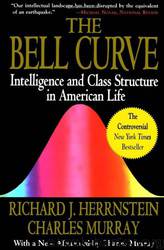The Bell Curve: Intelligence and Class Structure in American Life by Richard J. Herrnstein

Author:Richard J. Herrnstein
Language: eng
Format: mobi
Tags: Educational
ISBN: 9780684824291
Publisher: Free Press
Published: 1994-01-02T00:00:00+00:00
THE “EDGE” IN AFFIRMATIVE ACTION
People may agree that they want affirmative action in higher education until they say more precisely what they mean by it. Then they may disagree. But whatever the argument, it would help to have some data about how colleges and universities have translated the universal desire for greater fairness in university education into affirmative action programs. Our first goal is to inform the debate with such data.
At first glance, ours may seem an odd objective, for certain kinds of data about affirmative action are abundant. Universities and businesses keep detailed numbers about the numbers of minorities who apply and are accepted. But data about the core mechanism of affirmative action—the magnitudes of the values assigned to group membership—are not part of the public debate.
This ignorance about practice was revealed in 1991 by a law student at Georgetown University, Timothy Maguire, who had been hired to file student records.2 He surreptitiously compiled the entrance statistics for a sample of applicants to Georgetown’s law school and then published the results of his research in the law school’s student newspaper. He revealed that the mean on the Law School Aptitude Test (LSAT) differed by a large margin for accepted black and white students.
In the storm that ensued, an official at the law school sent a letter to Maguire’s fellow students condemning his article. Black student groups called for Maguire’s expulsion. Hardly anyone would acknowledge that Maguire’s numbers even raised a legitimate issue. “Incomplete and distorted information about minority qualifications for admission into the Law Center renew the long-standing and intellectually dishonest myth that they are less qualified than their white counterparts to compete in school, perform on the job or receive a promotion,” wrote the authors of an op-ed article in the Washington Post,3 and that seemed to be the prevailing attitude. The numerical magnitude of the edge given to members of certain groups—the value assigned to the state of being black, Latino, female, or physically disabled—was not considered relevant.
Such edges are inherent in the process. In as neutral and precise language as we can devise: Perfectly practiced, the traditional American ideal of equal opportunity means using exclusively individual measures, applied uniformly, to choose some people over others. Perfectly practiced, affirmative action means assigning a premium, an edge, to group membership in addition to the individual measures before making a final assessment that chooses some people over others.
The size of the premium assigned to group membership—an ethnic premium when it is applied to affirmative action for favored ethnic groups—is important in trying to judge whether affirmative action in principle is working. This knowledge should be useful not only (or even primarily) for deciding whether one is “for” or “against”affirmative action in the abstract. It should be especially useful for the proponents of affirmative action. Given that one is in favor of affirmative action, how may it be practiced in a way that conforms with one’s overall notions of what is fair and appropriate? If one opposes affirmative action in
Download
This site does not store any files on its server. We only index and link to content provided by other sites. Please contact the content providers to delete copyright contents if any and email us, we'll remove relevant links or contents immediately.
| African-American Studies | Asian American Studies |
| Disabled | Ethnic Studies |
| Hispanic American Studies | LGBT |
| Minority Studies | Native American Studies |
Cecilia; Or, Memoirs of an Heiress — Volume 1 by Fanny Burney(31332)
Cecilia; Or, Memoirs of an Heiress — Volume 3 by Fanny Burney(30934)
Cecilia; Or, Memoirs of an Heiress — Volume 2 by Fanny Burney(30889)
The Great Music City by Andrea Baker(21283)
We're Going to Need More Wine by Gabrielle Union(18072)
Bombshells: Glamour Girls of a Lifetime by Sullivan Steve(13108)
Pimp by Iceberg Slim(12931)
All the Missing Girls by Megan Miranda(12747)
Fifty Shades Freed by E L James(12451)
Norse Mythology by Gaiman Neil(11883)
Talking to Strangers by Malcolm Gladwell(11876)
Crazy Rich Asians by Kevin Kwan(8349)
Mindhunter: Inside the FBI's Elite Serial Crime Unit by John E. Douglas & Mark Olshaker(7833)
The Lost Art of Listening by Michael P. Nichols(6472)
Enlightenment Now: The Case for Reason, Science, Humanism, and Progress by Steven Pinker(6405)
Bad Blood by John Carreyrou(5768)
The Four Agreements by Don Miguel Ruiz(5510)
Weapons of Math Destruction by Cathy O'Neil(5036)
We Need to Talk by Celeste Headlee(4868)
